How to Installing Aluminum Baffle Ceilings?
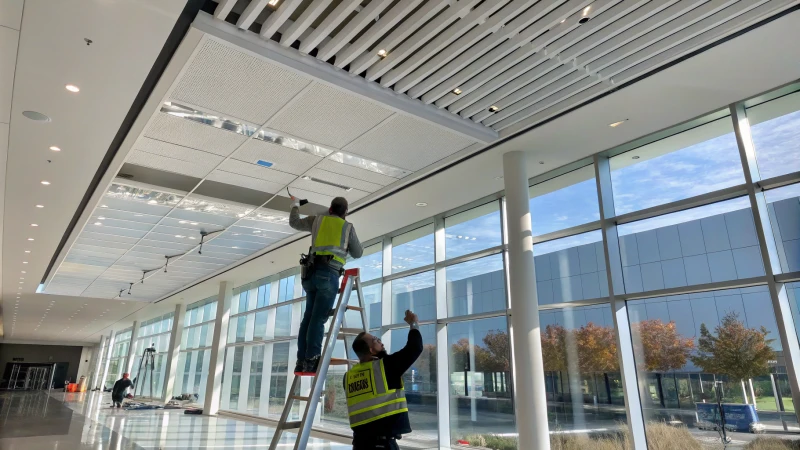
Transform your space with sleek aluminum baffle ceilings!
Aluminum baffle ceilings are a stylish and functional choice for modern interiors, offering benefits like fire resistance, noise reduction, and enhanced aesthetics. Follow this comprehensive guide for a step-by-step installation process that ensures quality results.
Ready to elevate your interior design? Dive into our detailed guide and discover the tools, techniques, and tips needed to install aluminum baffle ceilings successfully.
What are Aluminum Baffle Ceilings and Their Advantages?
Aluminum baffle ceilings are a modern architectural feature gaining popularity in commercial design. But what exactly are they, and what advantages do they offer?
Aluminum baffle ceilings are suspended panels that enhance aesthetics and acoustics in commercial spaces. Their key advantages include durability, sound absorption, fire resistance, and sustainability, making them an ideal choice for modern interiors.

Understanding Aluminum Baffle Ceilings
Aluminum baffle ceilings are innovative architectural features designed to enhance the aesthetic and functional aspects of commercial spaces.
These ceilings consist of long, narrow panels (baffles) made from aluminum, which are suspended from the ceiling. This design not only adds a modern touch but also provides excellent sound absorption and durability.
The use of aluminum as a primary material ensures that these ceilings are lightweight yet robust, making them suitable for various applications.
For a detailed overview of their benefits, read more about the modern ceiling options.
Key Advantages of Aluminum Baffle Ceilings
- Aesthetic Appeal:
Aluminum baffle ceilings create a visually stunning effect in any space. Their sleek lines and customizable finishes allow designers to tailor them to match the overall theme of a room.
By using different colors and orientations, one can achieve a unique look that enhances the visual appeal of the environment. - Sound Absorption:
These ceilings are designed to improve acoustics in commercial settings. The spacing between baffles allows sound to dissipate rather than bounce around, making them ideal for environments like offices and auditoriums.
For tips on sound management, check out acoustic solutions for interiors. - Durability and Maintenance:
Aluminum is known for its corrosion resistance and longevity. Baffle ceilings can withstand various environmental factors, making them perfect for high-traffic areas.
Their easy-to-clean surface ensures that maintenance is straightforward and cost-effective. - Sustainability:
As aluminum is recyclable, using baffle ceilings can contribute to environmentally friendly building practices.
Moreover, they can help improve energy efficiency by reflecting light and heat. - Fire Resistance:
Aluminum baffle ceilings offer excellent fire resistance, which is crucial for safety in commercial buildings.
This feature is often mandated by building codes, making these ceilings a smart choice for compliance.
Comparison with Traditional Ceiling Options
| Feature | Aluminum Baffle Ceilings | Traditional Ceilings |
|---|---|---|
| Aesthetic Flexibility | High | Moderate |
| Sound Absorption | Excellent | Variable |
| Durability | High | Low to Moderate |
| Maintenance | Easy | Often Difficult |
| Sustainability | Yes | Depends on Material |
Aluminum baffle ceilings stand out for their versatility and modern appeal, making them a preferred choice among architects and designers today.
For more insights into installation tips, refer to installation guides for ceiling systems1.
How Do Aluminum Baffle Ceilings Compare to Traditional Ceilings?
Discover how aluminum baffle ceilings stack up against traditional ceiling options in functionality, aesthetics, and more!
Aluminum baffle ceilings outperform traditional ceilings by offering superior aesthetics, enhanced acoustic performance, ease of installation with preparation, and long-lasting durability. Discover the advantages today!
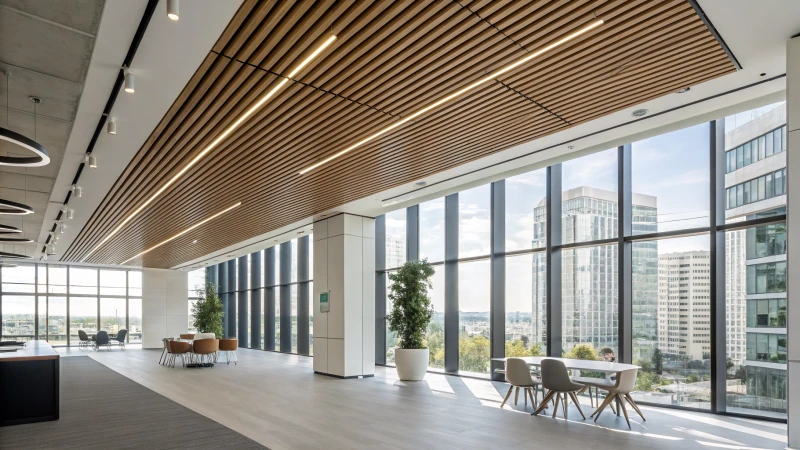
Aesthetic Appeal
Aluminum baffle ceilings are renowned for their modern and sleek designs, making them a popular choice in contemporary commercial spaces. Unlike traditional ceilings, which may seem flat and uninspiring, baffle ceilings add depth and visual interest. Their linear arrangements can create stunning patterns, enhancing the overall aesthetic of a room.
For example, by choosing varying widths and lengths of baffle panels, designers can create unique visual effects that draw the eye upward, promoting a sense of spaciousness. This is particularly useful in areas like lobbies or open-plan offices where first impressions matter.
If you’re looking for design inspiration, check out these innovative ideas to utilize baffle ceilings effectively.
Acoustic Performance
One of the primary advantages of aluminum baffle ceilings over traditional ceilings is their acoustic properties. Traditional ceilings often struggle with sound absorption, leading to echoes and noise issues in large spaces. In contrast, baffle ceilings are designed to enhance sound insulation due to their unique structure.
| Comparison Table: Acoustic Performance | Feature | Aluminum Baffle Ceilings | Traditional Ceilings |
|---|---|---|---|
| Sound Absorption | High | Moderate | |
| Noise Reduction Capability | Excellent | Good | |
| Customization for Acoustics | Yes | Limited |
This makes aluminum baffle ceilings an excellent choice for environments requiring noise control, such as auditoriums or conference rooms.
Installation Ease
While both ceiling types have their installation processes, aluminum baffle ceilings typically require a more complex setup due to the need for precise alignment and spacing. However, many installers find the process straightforward once familiar with the layout planning.
| Installation Comparison | Aspect | Aluminum Baffle Ceilings | Traditional Ceilings |
|---|---|---|---|
| Preparation Time | Moderate | Low | |
| Complexity | Higher | Lower | |
| Tools Required | Specialized (rails, hooks) | Standard (drywall tools) |
For those interested in detailed installation steps, consider reviewing our guide on installation tips2.
Durability and Maintenance
Durability is another key factor where aluminum baffle ceilings shine. They are resistant to moisture, corrosion, and fire, making them a superior choice for various environments compared to traditional materials like drywall or tiles.
| Durability Comparison | Feature | Aluminum Baffle Ceilings | Traditional Ceilings |
|---|---|---|---|
| Fire Resistance | Excellent | Moderate | |
| Moisture Resistance | High | Low | |
| Lifespan | 30+ years | 10-20 years |
This longevity means that while the initial investment might be higher, the long-term savings on repairs and replacements can make baffle ceilings more economical in the long run.
Conclusion
As we explore further into the functionalities and advantages of aluminum baffle ceilings compared to traditional options, it’s clear they offer distinct benefits that cater to modern design needs. From aesthetics to acoustics, each aspect warrants consideration for anyone planning a renovation or new construction project.
What Tools and Materials Do You Need for Installation?
Installing aluminum baffle ceilings requires specific tools and materials for a successful project. Knowing what to gather beforehand can streamline your process significantly.
To install aluminum baffle ceilings, you will need tools such as a power drill, measuring tape, level tool, and materials including aluminum baffle panels, ceiling rails, hooks, and screws.
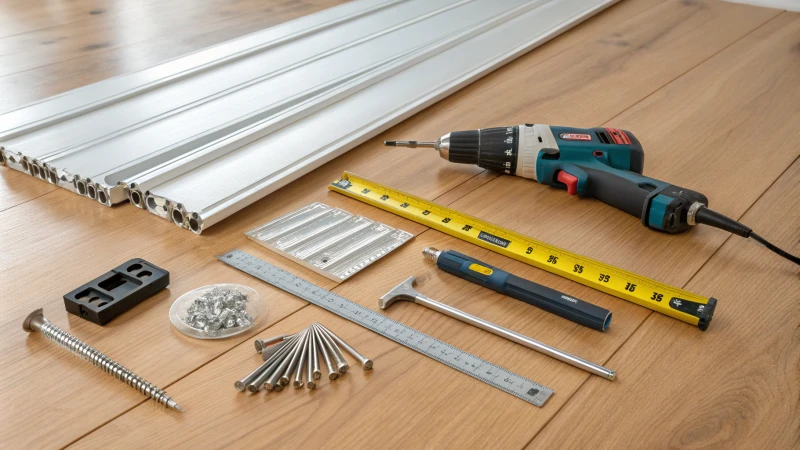
Essential Tools for Installation
When embarking on an installation project, having the right tools is paramount. Here’s a comprehensive list:
| Tool | Purpose |
|---|---|
| Power Drill | For making holes and driving screws |
| Measuring Tape | To measure lengths accurately |
| Level Tool | Ensures surfaces are even |
| Hooks | Supports the baffle panels |
| Screwdriver Set | For tightening screws |
Using these tools effectively ensures that your installation process runs smoothly. For instance, the right measuring techniques can drastically reduce errors in your layout.
Required Materials
In addition to tools, certain materials are essential for the installation of aluminum baffle ceilings:
- Aluminum Baffle Panels: These are the primary components that create the ceiling.
- Ceiling Rails: These rails support the baffles and need to be securely fixed.
- Screws: Necessary for attaching the panels and rails together.
Here’s a quick overview of material specifications:
| Material | Specification |
|---|---|
| Aluminum Baffle Panel | Lightweight, durable, and corrosion-resistant |
| Ceiling Rails | Must be robust enough to hold weight |
| Screws | Stainless steel recommended for longevity |
Choosing high-quality materials will significantly impact the durability of your installation. Learn more about the best material options.
Preparation Checklist
Before starting your installation, it’s wise to prepare a checklist to ensure you have everything needed. Here’s a simple checklist to consider:
- Aluminum baffle panels
- Ceiling rails
- Power drill and bits
- Measuring tape
- Level tool
- Hooks
- Screws and anchors
This preparation can save you time and frustration during your project. Find out more about effective preparation strategies that can make your installation seamless.
Additional Tips for Success
- Double Check Measurements: It’s easy to make mistakes in measuring; always double-check.
- Safety Gear: Don’t forget gloves and safety glasses to protect yourself during installation.
- Organize Your Workspace: A tidy workspace can prevent accidents and help you find tools quickly.
These tips can enhance your efficiency and safety during installation. Discover more expert tips on safety in DIY projects3.
What is the Step-by-Step Process for Installing Aluminum Baffle Ceilings?
Installing aluminum baffle ceilings can transform your space, but it requires a clear step-by-step approach. Let’s dive into the process!
The step-by-step process for installing aluminum baffle ceilings involves gathering tools, preparing the workspace, installing ceiling rails, attaching baffle panels, ensuring safety, and maintaining them effectively.
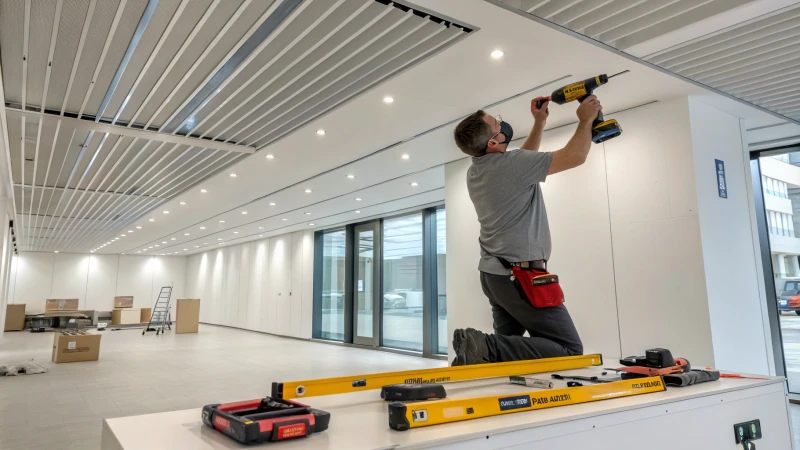
Step 1: Gather Your Tools and Materials
Before you begin the installation of aluminum baffle ceilings, it’s essential to gather all the necessary tools and materials. This preparation step ensures that you can work efficiently without interruptions.
Here’s a detailed checklist:
| Tools | Materials |
|---|---|
| Power Drill | Aluminum Baffle Panels |
| Measuring Tape | Ceiling Rails |
| Level Tool | Hooks |
| Screwdriver | Screws |
| Safety Goggles | Anchors (if needed) |
Having everything ready will allow you to focus on the installation process without having to make multiple trips to the hardware store.
Step 2: Prepare Your Workspace
Before installation, ensure that your workspace is clear and ready. This involves:
- Cleaning the Ceiling: Remove any debris or old materials to create a clean surface.
- Measuring and Marking: Use your measuring tape to determine where the ceiling rails will be installed. Mark these spots clearly, as this will guide your installation.
- Planning Layout: Consider how you want your baffle panels to align, ensuring even spacing for aesthetic appeal.
Step 3: Install the Ceiling Rails
Begin the installation by securing the ceiling rails. Here’s how:
- Align the Rails: Based on your measurements, position the main ceiling rails along the marked lines.
- Secure with Screws: Use your power drill to fix the rails in place, making sure they are level.
- Check Stability: Ensure that the rails are firmly attached and can support the weight of the baffle panels.
Step 4: Attach Baffle Panels
Now it’s time to install the aluminum baffle panels:
- Positioning: Align each panel with the rails, ensuring they fit snugly into place.
- Using Hooks: Secure each panel with hooks for added stability. Be sure to maintain uniform spacing between each panel for a professional finish.
- Final Adjustments: Once all panels are installed, step back and check for alignment and aesthetics.
Safety Measures During Installation
Safety is paramount when working with tools and materials. Here are some tips:
- Always wear safety goggles to protect your eyes from dust and debris.
- Use gloves when handling sharp edges of aluminum panels.
- Ensure your workspace is well-lit to avoid accidents.
Maintenance Tips for Aluminum Baffle Ceilings
To keep your baffle ceilings looking their best:
- Regularly dust the panels to prevent buildup.
- Clean with a damp cloth using mild detergent to maintain shine without damaging the finish.
By following these steps and tips, you can successfully install aluminum baffle ceilings that enhance both the functionality and aesthetic of your space. For more in-depth information about installation techniques, check out our detailed guide and recommended tools.
What Common Mistakes Should You Avoid During Installation?
Installing aluminum baffle ceilings can be rewarding but fraught with challenges. Discover key mistakes to avoid during installation to ensure success.
To ensure a successful installation of aluminum baffle ceilings, avoid common mistakes such as neglecting preparation, incorrect measurements, skipping layout planning, ignoring safety precautions, and not testing before finalizing.
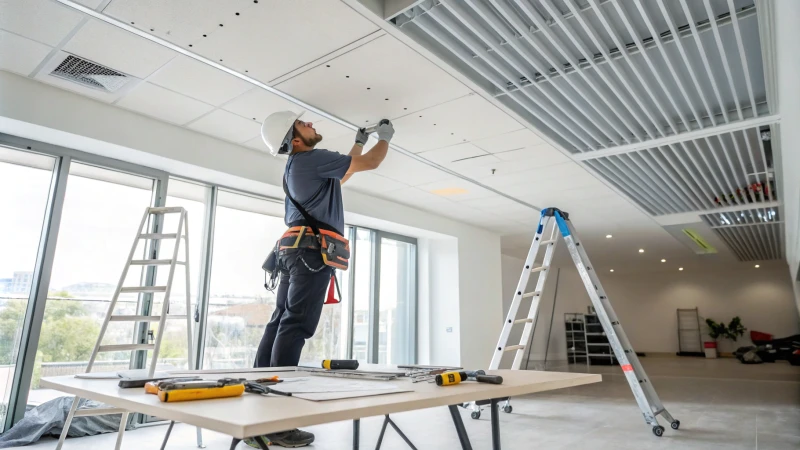
Overlooking Preparation Steps
| One of the most common mistakes during installation is neglecting the preparation phase. Proper preparation can save time and avoid costly errors later on. Make sure to gather all necessary tools and materials beforehand. For example, having a list like this can help: | Tools/Materials | Purpose |
|---|---|---|
| Measuring Tape | For accurate measurements | |
| Leveling Tool | To ensure surfaces are even | |
| Power Drill | For installing screws | |
| Aluminum Baffle Panels | The main material being installed |
This checklist ensures you won’t have to pause the installation to hunt for missing tools.
You can find more about the importance of preparation4 in any successful installation process.
Incorrect Measurements
Another frequent pitfall is failing to take accurate measurements.
Inaccurate measurements can lead to poor fitting and alignment issues, which can compromise the overall look and functionality of your installation.
Use the measuring tape diligently and double-check your measurements before cutting any material.
An effective strategy is to mark your measurements clearly, like this:
- Measure the width and height of the area.
- Write down measurements on a notepad.
- Compare with your baffle panel dimensions to ensure compatibility.
Skipping the Layout Planning
Planning your layout is crucial for a successful installation.
Skipping this step can lead to uneven spacing or misaligned panels.
Take time to sketch out your ceiling layout before starting the installation.
Use a diagram like this for clarity:
+---------------------+
| |
| Panel A |
| |
+---------+-----------+
|
|
+---------+-----------+
| |
| Panel B |
| |
+---------------------+A well-planned layout will enhance both the aesthetics and functionality of your ceiling. For more tips, check out effective layout strategies.
Ignoring Safety Precautions
Safety should never be overlooked during installations.
Neglecting safety protocols can lead to accidents and injuries.
Always wear appropriate safety gear, such as gloves and goggles.
Additionally, be aware of your surroundings, especially if you are using power tools.
For comprehensive safety tips, refer to installation safety guidelines.
Not Testing Before Finalizing
Finally, one mistake that can be detrimental is not testing the installation before finalizing it.
Once you think you are done, it’s essential to check that everything is secure and functioning as intended.
This means ensuring that panels are aligned properly and that any lighting fixtures or sound systems are operational. Performing a quick test can prevent future headaches.
By avoiding these common mistakes, you can ensure a smoother installation process and achieve better results in your projects.
Conclusion
Learn how to install aluminum baffle ceilings with this detailed guide covering tools, materials, and step-by-step instructions for a successful installation.
-
Explore more about different ceiling materials and their pros and cons. ↩
-
Learn more about installation processes for both ceiling types and find out which is easier. ↩
-
Learn about safety measures that can protect you while working on installation projects. ↩
-
Learn the top mistakes that could derail your installation project and how to avoid them effectively. ↩



